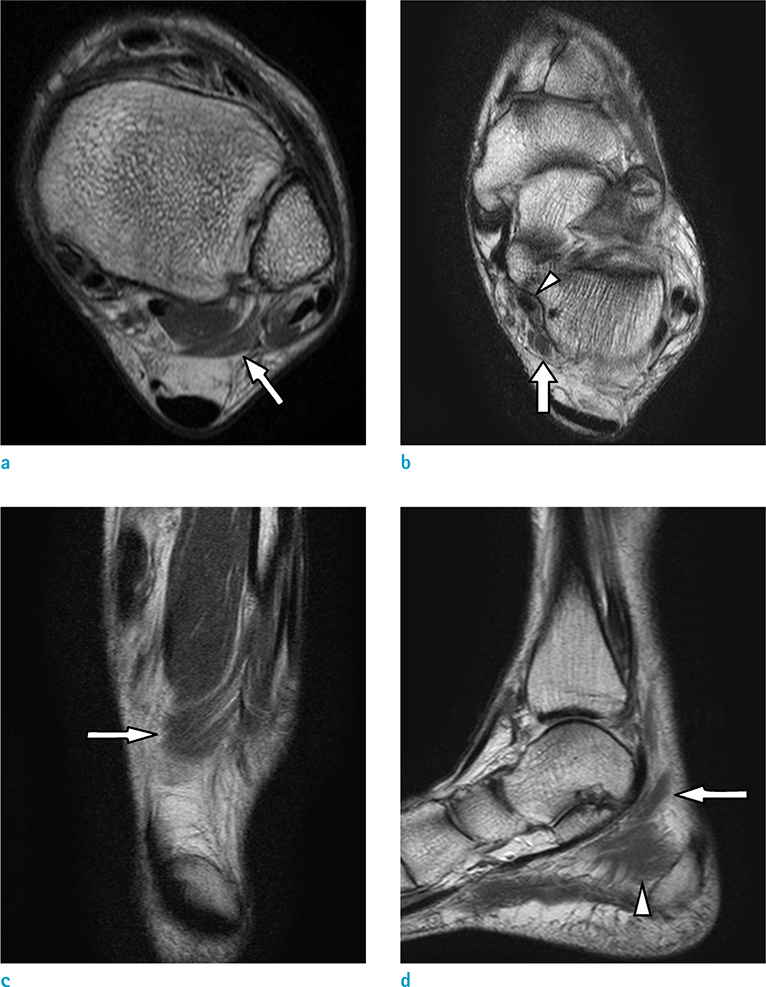Investig Magn Reson Imaging.
2016 Jun;20(2):123-126. 10.13104/imri.2016.20.2.123.
The MRI Findings of Flexor Digitorum Accessorius Longus Muscle: a Case Report
- Affiliations
-
- 1Department of Radiology, Seoul Paik Hospital, Inje University College of Medicine, Seoul, Korea. jcshim96@unitel.co.kr
- KMID: 2327425
- DOI: http://doi.org/10.13104/imri.2016.20.2.123
Abstract
- The flexor digitorum accessorius longus (FDAL) is the most common accessory muscle found in the posterior compartment of the ankle area. The accessory muscle in this area such as the FDAL may be incidentally identified on magnetic resonance images (MRI). There are some case reports about the FDAL in cadaver researches. However, the MRI findings about the FDAL have been reported in a few cases. In this paper, we report a case of the FDAL incidentally identified on MRI with review of the literature about the FDAL.
Keyword
MeSH Terms
Figure
Reference
-
1. Bowers CA, Mendicino RW, Catanzariti AR, Kernick ET. The flexor digitorum accessorius longus-a cadaveric study. J Foot Ankle Surg. 2009; 48:111–115.2. Sookur PA, Naraghi AM, Bleakney RR, Jalan R, Chan O, White LM. Accessory muscles: anatomy, symptoms, and radiologic evaluation. Radiographics. 2008; 28:481–499.3. Ottone NE, Tejedor MN, Blasi E, Medan CD, Fuentes R, del Sol M. Morphological description of the flexor digitorum accessorius longus muscle and its clinical significance. Int J Morphol. 2015; 33:611–619.4. Gumusalan Y, Kalaycioglu A. Bilateral accessory flexor digitorium longus muscle in man. Ann Anat. 2000; 182:573–576.5. Cheung YY, Rosenberg ZS, Colon E, Jahss M. MR imaging of flexor digitorum accessorius longus. Skeletal Radiol. 1999; 28:130–137.6. Hwang SH, Hill RV. An unusual variation of the flexor digitorum accessorius longus muscle--its anatomy and clinical significance. Anat Sci Int. 2009; 84:257–263.7. Peterson DA, Stinson W, Lairmore JR. The long accessory flexor muscle: an anatomical study. Foot Ankle Int. 1995; 16:637–640.8. Georgiev GP, Jelev L, Kinov P, Vidinova NK. A rare instance of an accessory long flexor to the second toe. Int J Anat Var. 2009; 2:108–110.9. Eberle CF, Moran B, Gleason T. The accessory flexor digitorum longus as a cause of flexor hallucis syndrome. Foot Ankle Int. 2002; 23:51–55.10. Mellado JM, Rosenberg ZS, Beltran J, Colon E. The peroneocalcaneus internus muscle: MR imaging features. AJR Am J Roentgenol. 1997; 169:585–588.11. Kinoshita M, Okuda R, Morikawa J, Abe M. Tarsal tunnel syndrome associated with an accessory muscle. Foot Ankle Int. 2003; 24:132–136.
- Full Text Links
- Actions
-
Cited
- CITED
-
- Close
- Share
- Similar articles
-
- Cases of Distal Lower Leg Reconstruction with Flexor Digitorum Longus Muscle Flaps
- Double Gantzer's Muscles by Four Muscle Bellies and Its Clinical Significance: A Case Report
- Separated muscle belly of the flexor digitorum brevis for the fifth toe: a case report
- Congenital Absence of the Flexor Digitorum Profundus: A Case Report
- Flexor Pollicis Longus Reconstruction in Patient with the Linburg-Comstock Syndrome


